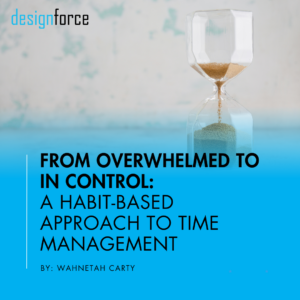By: Kyra Merrill
NBA-legend & beloved author, John Wooten once said “It is the little details that are vital. Little things make big things happen.” In an ever-changing and fast-paced world, where priorities and deadlines are constantly competing for our attention, it is easy to forget about the small habits we build and how much of an impact they have on our day-to-day life.
I’ve always loved celebrating small wins. When I was a kid, I can remember that I loved any excuse for a party, a sweet treat or a handwritten card. As I have grown older, celebrating wins, big and small, is a habit that I have held close, letting it shape the way I go through my days and the outlook I have about the world around me. When I started my first job, I took immediate notice to the fact that everyone around me had a strong praise-first mentality. By that, I mean that all my teammates were quick to be vocal when they saw a job well done. Whether it was lending a hand with an unanticipated project or helping take care of someone else’s desk when they were away, I deeply admired how frequently I heard the words: “Thank you,” and “Good Job!” Saying thank you and being able to pinpoint and articulate the positive actions of another person became second nature to me as I surrounded myself with professionals who had truly mastered the art of praise.
The 5:1 Praise Principle
Praise in the workplace is a far too often overlooked concept. John Gottman, an American psychologist, popularized the 5:1 praise principle. He remarked that for every piece of critical feedback given, there should be five pieces of positive feedback. When I think of this concept, I don’t think of a massive compliment sandwich where you give a bunch of positive feedback all at once with a little critique wedged in, but rather I think of someone who is consistent with highlighting and recognizing the positives, so that when a negative rolls around, it doesn’t feel quite as hard to receive. If you think about it, most of us do more good than bad. If we can focus in on and vocalize these positive contributions, we will create a more psychologically safe environment that is more receptive to constructive criticism.
Identifying and speaking on the positive contributions of others is a valuable habit for professionals to develop, but what does it actually look like? Typically, it’s not an overnight change. Building habits takes time. For starters, I was always taught that nice things should never be left unsaid. Next time you have a positive thought about someone else, why not share it? If you’re having a hard time drawing positives, challenge yourself to highlight three “wins” at the end of every week and reach out to those who helped you get there, even if just to say thank you. These messages or conversations don’t need to be long or complicated, but a few words can go a long way. If your firm uses Microsoft Teams, try using the “praise” function in the toolbar, and have some fun with it! Again, habits don’t form without intention and consistency, but if you keep at it, these positive mindset changes can make a big difference in your day-to-day.
Building Effective Praise
One of the most common roadblocks between professionals and praise is simply not knowing how to give it. In order to understand how we can deliver meaningful praise, I think it’s important to identify the different types of praise, which are public, private and peer-to-peer. Public praise boosts visibility for positive contributions and encourages the emulation of good behaviors, while also boosting morale and building culture. Private praise is important for building a strong personal rapport between supervisors and direct reports and increasing engagement by making employees feel seen and valued. Peer-to-peer praise is perhaps one of the most vital as it reduces overreliance on recognition from management and creates a safe and positive workplace among team members.
Timing is also a critical element of the craft of giving praise. Delaying praise can run the risk of coming off less authentic, as positive reinforcement is most effective when it’s immediate. Recognize contributions in real time to show that you’re paying attention and you care about the process just as much as the outcome. If we wait until we have outcomes to deliver praise, we are sometimes sending a message that effort and hard work don’t have value unless they’re tied to success. Delivering praise throughout the process, regardless of the end result, reinforces a healthy relationship by leveraging mistakes as learning opportunities.
Lastly, be intentional about delivering praise that is specific and genuine. Instead of: “Great work with this project!” Try: “Your consistency, attention to detail, and resilience really made the difference with this project. Well done!” Praise does not need to be a novel, but by paying attention to small ways that we can increase its efficacy, a little will go a long way!
Long-term Impact of Having a Praise Culture
Maybe all of these things have sounded far-fetched or like a chore to implement, and you may be wondering, why does any of this matter? There are several long-term impacts of making praise part of your firm’s culture. Most importantly, daily praise reduces turnover by driving engagement. According to Gallup’s State of the American Workforce Report, organizations that double the frequency of recognition see a 24% improvement in job quality and a 27% reduction in absenteeism. Additionally, Quantum Workplace reported that 53% of employees who left their jobs say that a lack of recognition was a key reason for their departure. As someone who frequently hears directly from AEC professionals about what they are looking for in opportunities, recognition consistently ranks close to the top of the list.
Finally, praise is crucial to developing a strong leadership pipeline. Well-praised employees will have more confidence to grow into effective leaders over time. A primary barrier to developing internal leaders is the confidence issue. Many emerging leaders just aren’t seeing themselves as leaders, creating a roadblock for effective succession planning. Not only does praise empower professionals to want to move into leadership roles, but it also contributes to their ultimate success as leaders, as praise creates more well-rounded and interpersonally skilled employees who will be more adept as leaders. Praising specific behaviors can reinforce positive habits that will follow professionals as they grow into new positions. The confidence derived from consistent praise will also lead to healthy risk-taking and innovation from employees, fostering continuous learning and development in a unique way by creating safety to transform “failures” into growth.
Start small
The topic of praise in the workplace is complex and evolving daily. The best advice I have, from one professional to another is just like Wooten said: “little things make big things happen.” An old proverb says that the man who moves a mountain starts by carrying small stones. Challenge yourself to give one meaningful praise tomorrow and watch the ripple effect!

Related Posts
Let's learn together.
Stay inspired and in the know on all things A|E|C.
Sign up for our monthly newsletter.










